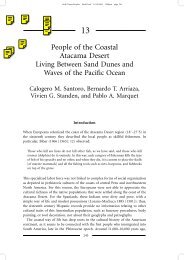Late Quaternary History of the Atacama Desert.
Late Quaternary History of the Atacama Desert.
Late Quaternary History of the Atacama Desert.
Create successful ePaper yourself
Turn your PDF publications into a flip-book with our unique Google optimized e-Paper software.
80 part one environmental historylinked to mean annual precipitation, which increases from almost nothingat about 2400 metres to 200 millimetres per year at 4000 metres. Along<strong>the</strong> Andean slope, a sparse vegetation <strong>of</strong> shrubs and small herbs, knownas <strong>the</strong> prepuna, appears at 2900 metres and gradually transitions into <strong>the</strong>puna (locally called tolar) vegetation belt. The puna belt, between 3100 and3900 metres, is dominated by shrubs <strong>of</strong> <strong>the</strong> Asteraceae and Solanaceae withnumerous summer annuals and columnar cacti. High Andean grasslanddominated by tussock grasses such as Stipa, Nassella and Festuca is foundabove 3900 metres. A more heterogenous mix <strong>of</strong> vegetation occurs along <strong>the</strong>Cordillera Domeyko, with impoverished Stipa grassland found above 3400metres and slightly wetter conditions on <strong>the</strong> east-facing slopes with tolarshrubs extending down to 3100 metres. These same shrubs occur above 3200metres on <strong>the</strong> drier west-facing slopes.We collected rodent middens from two major areas in <strong>the</strong> central <strong>Atacama</strong>.The first area is in <strong>the</strong> prepuna along <strong>the</strong> west-facing and east-facing slopes <strong>of</strong><strong>the</strong> nor<strong>the</strong>rn Cordillera Domeyko, between 3100 and 3300 metres <strong>of</strong> elevation.The o<strong>the</strong>r midden area is along an escarpment <strong>of</strong> volcanic rocks at <strong>the</strong> sou<strong>the</strong>rnportion <strong>of</strong> <strong>the</strong> Salar de <strong>Atacama</strong>, known as Tilocalar (between 2400 and 3050metres), an area now mostly devoid <strong>of</strong> all but <strong>the</strong> most drought-resistant plants(for more details see Betancourt et al. 2000; Latorre et al. 2002, 2003).The Tilocalar series (44 middens) records vegetation invasions into whatis now absolute desert over <strong>the</strong> last 45,000 years (summarised in Fig. 6.1c).Major wet phases, indicated by more than 30 per cent extralocal plants (speciesnot found in <strong>the</strong> area today), presence <strong>of</strong> steppe (some grass species presentare found approximately 900 metres above <strong>the</strong> localities today) and tolar (puna)shrubs as well as summer annuals and columnar cacti, occurred sometimebefore 44,000 years ago and between 16,200 and 10,000 cal. BP. Minorpulses <strong>of</strong> increased precipitation occurred between 7000 and 3000 cal. BP,mostly evinced by increases in <strong>the</strong> number <strong>of</strong> prepuna perennials as well as<strong>the</strong> occasional appearance <strong>of</strong> summer annuals and tolar taxa. The few middensdated to between 40,000 and 22,000 cal. BP possess very dry assemblages,along with those marking <strong>the</strong> abrupt onset <strong>of</strong> aridity after 10,000 cal. BP.The poor plant assemblages present in middens younger than 3000 years oldalso indicate dry climates, possibly <strong>the</strong> driest over <strong>the</strong> last 22,000 years. The
















